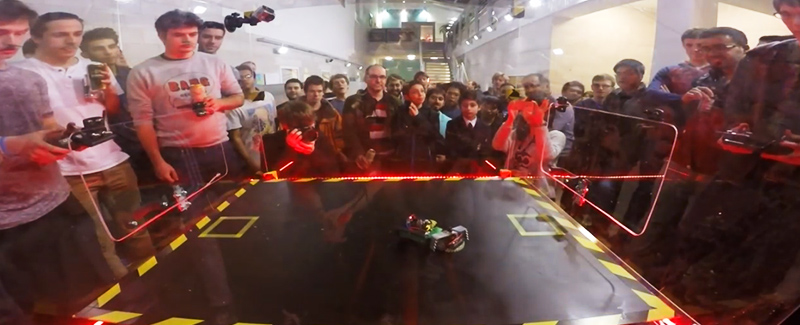“Ahhhh! They’re so cute! Wait a second, does that little robot have a spinning blade of death?!?!?” Yes, yes it does.
Welcome to Bristol University 2nd Annual Robot Wars Tournament. It’s loosely based on the old BBC show Robot Wars, where contestants would design and build fighting robots. This pint-sized version is just down right fun to watch. But don’t let their size fool you, some of these little bots pack a mean punch.
This competition follows the “Antweight World Series Rules” and must fit inside a 4 inch cube with a max weight of 150 grams. There are some not-so-fun rules attached to that, such as “No flame based weapons” and “no use of electricity as a weapon.” But hey, it still looks like a blast.
We can’t help but to think that a contest like this would be an amazing thing for local hacker spaces to set up and organize. The playing field seems to be a reasonable size, such that it could be set-up and torn-down without too much hassle. And with RC transmitters/receivers available so inexpensively these days, and ebay flooded with little robot parts from China, now seems like a perfect time to start a local robot competition. It might be a great way to draw people into making and hacking. You can watch the video of the competition and meet the makers after the break.
















These are sweet. Miniature mechanized death. No fire? What? Where’s the fun in that?
Does anyone know what the brains are for these things? And how they’re controlled? From what I can tell they look radio-controlled.
But it’s not your average Sumobot. This allows you to have weapons like the TV show counterpart.
HK-T6Av2 – £17
remote controlled -> they are not robots
start your own league with real robots?
My own league, with Blackjack and hookers!
http://i126.photobucket.com/albums/p100/lastofthebenders/FreeRep13-i-BB/SexyBender2-L.jpg
ah, forget the blackjack!
Cool stuff.
I do wish some rule could be invented to bias against wedge shapes though. They are just too dominant and thus make it a little dull.
Also, can we have flying stuff?
While wedges are boring, they can still be interesting to watch if the driver has any skill. (though “driver skill” is exceptionally rare) Also, a non-flat floor helps.
Both good points.
Robot Wars on “natural” terrain would be interesting.
love this, and will consider how we can do it here at UNSW
Would love to see a cross-Australia robot wars – Monash doesn’t have anything like that either.
I had just been thinking about internally, but between uni’s would be great! I will make sure to get this off the back burner/start encouraging the right people to do it.
Robowars is trying to put on an event for 30lb robots in Sydney at the end of May. More info can be found at: http://www.pozible.com/project/193751
Awesome stuff!
Would love to also see another class – autonomous! – That would bring the hackers out!
“robot”
Want to level the playing field for wedges? Just unlevel the playing field. Same for flapjack flippers.
First movie, 5 minute mark. That’s how you deal with wedges.
To stop impacts from trashing your spinning weaponry drive systems, build a viscous coupling filled with thick silicone grease. You’ll be able to get up to a speedy RPM yet when you whack the opponent your bot’s driveshafts wont get twisted and bent and the gears won’t get broken.
Or control it digitally and turn down the torque when rpms are achieved. Delay spinup when drop in rpm is detected
Interesting. Remarknl, can you comment on how that would work? It seems as if you have a spinning blade of death that is 1/2 the weight of your “bot” – no matter how you controlled the motor, all that energy is stored up in that rotating mass. Cutting the current to the motor isn’t going to save the action-reaction forces. But you peeked my curiosity. Do explain.
All a spinner drive-line need is a safe place to slip when overloaded. Friction belt drives work great for this. I’ve also used a friction-overload clutch and chain drive. I wouldn’t recommend a viscous coupling because it won’t limit peak torque as well as a sliding friction coupling.
Yey I am there right now.
If you’re looking for events near you, http://sparc.tools/ is a great resource for finding them. In addition to the event calendar there are rules and procedures documents that many North American and Australian events used as well as a forum.